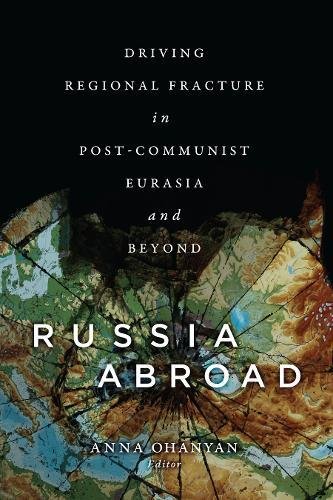 Russia Abroad: Driving Regional Fracture in Post-Communist Eurasia and Beyond is a bastion for clarity in a world ripe with dense international relations literature and brings together specialized security scholars from across the world in this edited volume. This work is tailor-made for those who are both academically inclined, in addition to those with a genuine interest in geopolitical and security-related issues in the contemporary Post-Soviet space. Often we associate the Cold War with the mid to late 20th-century history of international affairs, but there is a reason to suggest when reading this work that it never truly ended. This is the theoretical space in which Anna Ohanyan’s book Russia Abroad emerges. Ohanyan is a Richard B. Finnegan Distinguished Professor of Political Science and International Relations at Stonehill College. She is a leading network and regionalism scholar with two previous publications: NGOs, IGOs, and the Network Mechanisms of Post-Conflict Global Governance in Microfinance (2008) and Networked Regionalism as Conflict Management (2015) and brings years of extensive international fieldwork.
Russia Abroad: Driving Regional Fracture in Post-Communist Eurasia and Beyond is a bastion for clarity in a world ripe with dense international relations literature and brings together specialized security scholars from across the world in this edited volume. This work is tailor-made for those who are both academically inclined, in addition to those with a genuine interest in geopolitical and security-related issues in the contemporary Post-Soviet space. Often we associate the Cold War with the mid to late 20th-century history of international affairs, but there is a reason to suggest when reading this work that it never truly ended. This is the theoretical space in which Anna Ohanyan’s book Russia Abroad emerges. Ohanyan is a Richard B. Finnegan Distinguished Professor of Political Science and International Relations at Stonehill College. She is a leading network and regionalism scholar with two previous publications: NGOs, IGOs, and the Network Mechanisms of Post-Conflict Global Governance in Microfinance (2008) and Networked Regionalism as Conflict Management (2015) and brings years of extensive international fieldwork.
Russia Abroad is intricately crafted into three distinct parts. In the first part, Ohanyan carefully provides her rationale developing the Theory of Regional Fracture (TRF) touching upon her field experience and the rise of populism in the West. Building on the definition of fractured regions by leading scholars Nye, Buzan, and Waever she sets in motion her theory. TRF “…argues that fractured regions…occupy a specific institutional geographic and, as such, represent particular political and institutional systems.” Regional fracture, in other words, exist in part due to the “forced courting” of lesser actors. This courting is outlined by Robert Nalbandov, a leading foreign policy expert, and inserts Russia as the central actor to complement the theory. He explains the geopolitical nature of Russian behavior, in the interaction with peripheral states, collectively known as the “Near Abroad.”
Parts two and three are best categorized as empirical chapters. These sections demonstrate Russia’s use of regional fracture on lesser states. Specifically, part two focuses on states that once directly fell under the control of Moscow as part of the “spoke and wheel” visualization used throughout this work. Broadly categorized, these are states found in Eastern Europe, the South Caucasus, and Central Asia. Part III looks at actors “beyond” Russia’s immediate influence found in the Middle East and states belonging to former Yugoslavia.
Ohanyan concludes that local regional ties promote stability. American, European, and Russian foreign policy has been focused on bringing lesser states into their respective camps for decades through bilateral foreign policy cultivation. She notes that the practice is not sustainable over the long term and that a regional approach addressing conflicts (described in detail in this work) would eventually promote smart economic development.
One chapter is particularly fascinating given the backdrop of Armenia’s recent Velvet Revolution. Richard Giragosian’s, “Small States and the Large Costs of Regional Fracture: The Case of Armenia” offers a critical insight for those who want to gain a greater appreciation and understanding for the technical nuances of the country. In essence, Armenia is looking to “maximize its strategic options.” He looks to several examples to illustrate this point, notably its security relations with Moscow given the hostilities with Azerbaijan and the perceived threat from Turkey. On the economic front, he offers a more fluid neighborly dynamic. Armenia has extended friendly cooperation to the European Union and engagement with its neighbors Georgia and most notably Iran, which until recently has had limited economic relations. Overall this work makes the reader question what the role small actors, such as Armenia play in larger geopolitical games, but at a deeper level, question the role of diaspora communities play as sizable populations exist within the power blocs previously mentioned.
This book has received positive marks in the academic community. Paul F. Diehl, associate provost and director, Center for Teaching and Learning, Ashbel Smith Professor of Political Science, at the University of Texas, Dallas has said, “This is not just a book about Russian foreign policy. The new conceptualization of regional fracture and the accompanying theoretical framework are broadly applicable and provide an important counterweight to the often-exclusive focus on regional integration in the scholarly and policymaking communities.”
Editor’s Note: Daniel Lavigne is a former student and research assistant of Anna Ohanyan while attending Stonehill College (2014-2018). He is familiar with her research interest and theoretical frameworks.



Be the first to comment